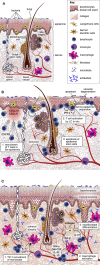Unraveling the Mechanisms of Cutaneous Graft-Versus-Host Disease
- PMID: 29770141
- PMCID: PMC5940745
- DOI: 10.3389/fimmu.2018.00963
Unraveling the Mechanisms of Cutaneous Graft-Versus-Host Disease
Abstract
The skin is the most common target organ affected by graft-versus-host disease (GVHD), with severity and response to therapy representing important predictors of patient survival. Although many of the initiating events in GVHD pathogenesis have been defined, less is known about why treatment resistance occurs or why there is often a permanent failure to restore tissue homeostasis. Emerging data suggest that the unique immune microenvironment in the skin is responsible for defining location- and context-specific mechanisms of injury that are distinct from those involved in other target organs. In this review, we address recent advances in our understanding of GVHD biology in the skin and outline the new research themes that will ultimately enable design of precision therapies.
Keywords: B cells; T cells; antigen-presenting cells; cutaneous graft-versus-host disease; microbiome; pathophysiology; repair mechanisms.
Figures

References
-
- Billingham RE. The biology of graft-versus-host reactions. Harvey Lect (1966) 62:21–78. - PubMed
-
- Filipovich AH, Weisdorf D, Pavletic S, Socie G, Wingard JR, Lee SJ, et al. National Institutes of Health consensus development project on criteria for clinical trials in chronic graft-versus-host disease: I. Diagnosis and staging working group report. Biol Blood Marrow Transplant (2005) 11(12):945–56.10.1016/j.bbmt.2005.09.004 - DOI - PubMed
Publication types
MeSH terms
Substances
Grants and funding
LinkOut - more resources
Full Text Sources
Other Literature Sources
Medical

